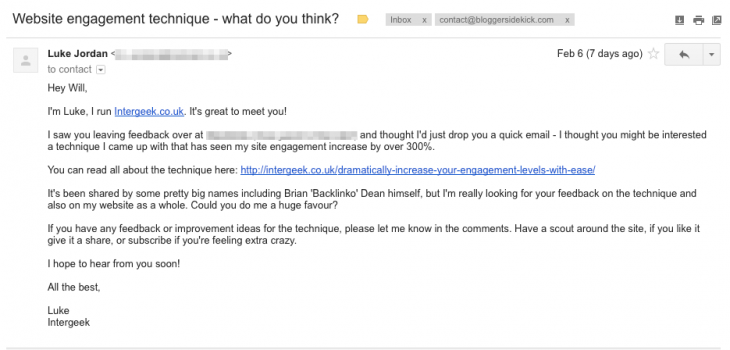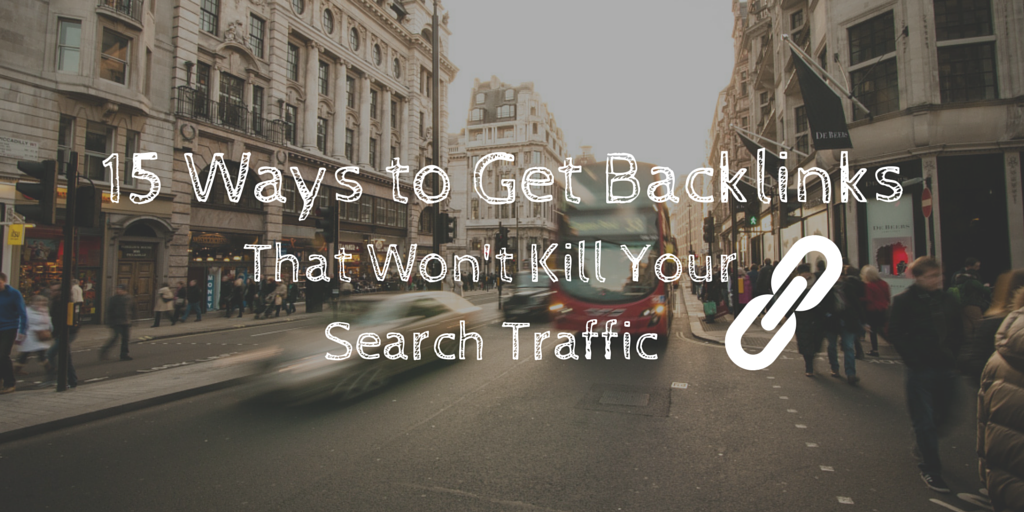
Some of the most renowned sites on the internet experienced a plummet in organic traffic as a result of Google’s Panda updates. This has left a lot of us uncertain about what works and what doesn’t when it comes to search rankings and SEO.
One thing we can be certain about is that when an authoritative domain links back to a page on your site, it will positively affect your search ranking. Google sees this link as a way to determine how trustworthy the content on that page is.
So backlinks are good.
But are all links good for your site?
The short answer is no. You don’t want to attract links from low quality sites. Too many low quality backlinks will actually hurt your search ranking, and hence your organic traffic. The reason Google decided to bring this rule in, is because people were trading, buying and stuffing links all over the place. Now the emphasis has shifted to content. High quality content that organically attracts links.
Note: The other thing to be aware of is the difference between do-follow and no-follow links. Linking domains will add a rel=”nofollow” tag to a hyperlink if they don’t want to pass on any benefit to the original source. The reason authority domains will do this is because too many do-follow links can detract from their own search ranking.
This post will focus on attracting quality do-follow links, that will positively influence your search ranking.
As a bonus I will provide a few ways to get no-follow links that generate more traffic to your site (a Google ranking factor) and indirectly help your SEO.
Let’s get started!
Disclaimer: This is another one of those lengthy, extreme detail posts. You may want to bookmark it and come back a few times to soak up all the information.
1. Create high quality content
Quality content is the slow burn of building links. The theory is that the more useful, in-depth and engaging your content is, the more people will want to link back to that content in the long-term.
But what is ‘high quality content’?
Lets dive deeper on three forms of content that are considered high quality.
Long form content
Why does longer form content get more backlinks?
The average article on page one of a Google search is over 2,000 words in length. Basically, Google wants to provide its users with the best possible content on any particular topic. Longer form content typically provides more value to those users and hence Google ranks it so.
Naturally, if you are popping up early in Google searches, more people will see your content. The more people that see your content, the more chance they will decide to reference it on their site as a credible source of further reading.
Bingo, a backlink for you.
Who does this well?
Where else better to go than the three musketeers of search. Arguably the internets most knowledge experts on search engine traffic; Rand Fishkin, Brian Dean and Neil Patel.
Rand is the self proclaimed ‘Wizard of Moz’, Brian is the search genius behind Backlinko and Neil Patel is the content king behind ventures such as KISSmetrics, Crazy Egg and more recently Quick Sprout.
All of these experts have one SEO tactic in common. Content with so much useful information, most people would try and sell it to you! Moz, Backlinko and Quick Sprout all provide what I would call ‘Online Books’ that attempt to cover a topic from start to finish in extreme detail. As with any book, they have an introduction and are broken down into chapters. (Note: The key difference between these resources and an e-book is that it is all for free and written into the site. E-books are typically downloadable pieces of content)
An awesome bonus benefit to this type of content is that it reduces your website’s bounce rate, because people click through the chapters one at a time as they read. This enables you to strategically place call-to-actions throughout.
You can check an example of each of them out here if you are interested to see what I’m talking about;
The Beginners Guide to SEO – Rand Fishkin at Moz
The Definitive Guide to Keyword Research – Brian Dean at Backlinko
The Complete Guide to Building Your Blog Audience – Neil Patel at Quick Sprout
SEO Training Guide: How To Do Keyword Research – FatJoe
Evergreen content
Evergreen content is timeless. It is created with the intention of serving your readers with helpful advice today, tomorrow and even in 6 months.
This type of content won’t require a lot of maintenance over time, but the best bloggers will revisit it and adjust its relevance. You know as well as I do that internet marketing is changing at a fast pace, and its unlikely any topic or viewpoint will be relevant for longer than 12 months.
Depending on how quickly things change in your industry will determine how easy it is to create evergreen content, but if you can find a way it’s definitely worth it.
Why should you write evergreen blog content?
Simple. Evergreen content (if written well, and extremely useful) will start to send more search engine traffic to your website. Naturally over time your content will accrue more backlinks, more social shares and inevitably generate more leads. You write it once, and the content works harder and harder for you over time. But only if you do it well.
An example of evergreen content
I had the privilege of picking the brain of Courtney Seiter, the epic content creator from Buffer when she was in Sydney not too long ago. Evergreen content is one of the contributing factors to the ongoing success of the Buffer blog, because older articles continue to bring new visitors to their website. Below is an example of a blog Courtney wrote about social media teams. This is a great example of evergreen content, because it is solving an ongoing challenge – the inability of social media teams to work together seamlessly. This type of content won’t all of a sudden become irrelevant any time soon.
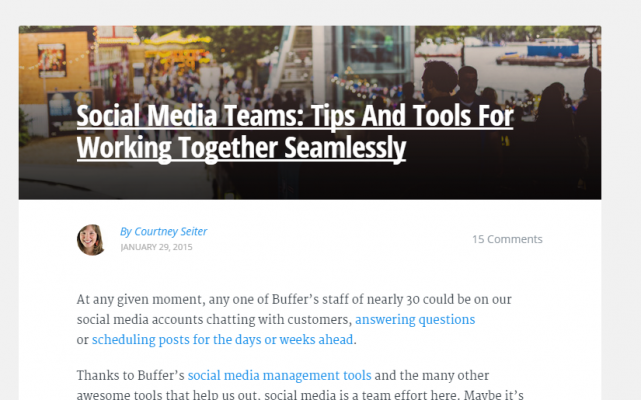
Another tactic that Buffer use to create evergreen content is to curate timeless list posts; such as ‘Must-Read Blogs‘ or ‘Best Curated Newsletters‘.
I’ve even given evergreen content a go here at Blogger Sidekick by creating a ‘Why Blogging Matters to Your Business’ infographic.
If you want to create some evergreen content yourself, think about a burning question your customers always ask, and have done for a while. Answer that question in a blog post.
Useful content
Useful content is the type of content that your readers will take action on. They will grab your tips and tactics, jot them down on a notepad and make an immediate change in an attempt to solve a deepheld challenge they face.
To be useful you need to first understand what your readers or customers are challenged by. What bad habits do they have? What one or two things are they constantly struggling with? What is inhibiting them from achieving their dreams?
If you start to create content that answers these questions, you become a source of consistent value in their life. The more people you have this effect on, the bigger your audience grows. The bigger your audience grows, the more chance you have of getting quality backlinks.
Useful content has some pretty impressive supporters when it comes to getting backlinks. I turned to George Thomas the epic podcaster and inbound marketing specialist from The Sales Lion and John Paul Aguiar – a blogging guru helping entrepreneurs and small businesses grow revenue through blogging. Here’s what they had to say about their favorite ways for getting backlinks;
@WillBluntAU Not focusing on getting back links from authority sites. : ) But creating Youtility content that people love.
— George B Thomas (@GeorgeBThomas) February 11, 2015
@WillBluntAU writing the best content that you can.. unique, helpful and to the point,
— John Paul Aguiar (@JohnAguiar) February 11, 2015
You know that high quality blog content is critical for getting backlinks, but how do you create it time and time again?
Check out the Shake ‘N’ Bake Method I propose in the first section of this blog at Bluewire Media.
2. Make your content visual and re-sharable
Visual content increases engagement. It’s as simple as that. My observation is that the most successful blogs spice up their written content with something a little more visual every now and then. Things such as SlideShare presentations, infographics or video content.
So why don’t you ever see a blog that is pushing out only infographics and no written text?
Written content is too important to forget. People retain knowledge that has been delivered through stories and metaphors. Not to mention search engines find it easier to crawl text and figure out what you are trying to say.
That being said, visual content is a great way to diversify your content and get more backlinks. When I took it to Twitter to ask the experts what their favorite link building tactic was, Rand Fishkin agreed;
@WillBluntAU Being authentic. Helping people. And making useful visuals 🙂
— Rand Fishkin (@randfish) February 11, 2015
Here are three ways you can get more backlinks with visual content
Infographics
Infographics are a great asset for your blog. A single, well-researched infographic can get you tons of handy backlinks.
But not everyone is taking advantage of this. Lets take a look at three common assumptions people make and how to overcome them;
Infographics are cool, but…
- “…they are too expensive to source and I don’t know how to make them myself” – You can create an infographic with piktochart even if you have never done anything creative in your life and it is totally FREE to start out.
- “…I just don’t have the time to create one” – No worries, you don’t want to give Piktochart a go because it can take a few hours out of your day. Instead, you can hire a designer on 99Designs or oDesk for a few hundred dollars.
- “…I wouldn’t know what information to put in an infographic” – We overthink this one. People just want to see something helpful and interesting. So if you’ve ever written a nice lengthy, helpful blog post you probably have the ingredients for an infographic.
If you are willing to overcome these assumptions and give it a go, infographics are a killer tactic for getting more backlinks to your blog. But to make the most of them you need to be proactive.
- Submit your infographic to sharing sites and directories. (Note: Make sure these are reputable sites, some infographic sites will hurt your search ranking)
- Include a code box underneath the infographic on your blog so it is easy for people to share.
- Reach out to bloggers or news sites and offer the infographic, accompanied with some descriptive text, as a guest post. (Note: Relationships are key for this one.)
Slideshare Presentations
SlideShare is like the YouTube of presentations. It’s a great way to represent your content visually, and attract a new audience to your website.
Why should you care about SlideShare?
It’s a shortcut to the top of a Google search for certain keywords because the SlideShare domain has serious authority. For best results you should make sure you;
- Optimize your SlideShare profile with a description and relevant links
- Include your keywords in the filename, heading, meta description and transcript of the SlideShare (Note: SlideShare automatically transcribes your slides into text, this is your transcript. But you can manually edit what this says.)
- Use visual storytelling, metaphors, images and helpful information to engage your audience
- Choose relevant tags that help people find your presentation when they search SlideShare
- Don’t over-do your slides with text. Make them easy to digest
- Embed links back to your site in your slides where it adds value to the reader (Note: Any links you include within the first 3 slides won’t be active, so try and optimize later slides for a specific call-to-action)
Cool, people are finding your SlideShare and engaging with your content. But how does this get you more backlinks?
You have included links in your slides that direct people back to your site, your SlideShare profile links people back to your site, and all SlideShare presentations are easily embedded within blog posts. So if your content is awesome, people will re-share your presentations to their audience.
Video Content
YouTube has a domain authority of 100… Basically it is as influential as a website can be! What that means is it is a valuable place to build backlinks. (Not to mention video is a great way to engage your customers)
Here’s how to use YouTube for gaining backlinks;
- Create a company YouTube channel and go through the profile set-up process. Within your profile you will have a link back to your site. (This one is do-follow)
- Develop video content, post it on YouTube and include relevant links in the description of your video. (These are no-follow but generate some decent traffic)
Easy, you just got a couple of really handy backlinks from YouTube. BUT as with any of these tactics if you don’t continue to add value, the links will become irrelevant. So only start a YouTube channel if you plan on maintaining it with regular, high quality content.
3. Build meaningful relationships and reach out to linkers
We can’t forget relationships, they are the backbone to any successful link building strategy.
At the most basic level, relationships develop when something of value is exchanged between two parties. In the blogosphere this may be as little as a Tweet, or as chunky as an affiliate partnership and everything inbetween. The more meaningful relationships you build in your industry, the more links you will accrue over time.
But what happens if you don’t currently have a whole bunch of these relationships, and you want to get links?
Use link building as an opportunity to make more friends and expand your influence.
After you have written an epic blog post (discussed in the quality content section) you need to identify link opportunities. There are a bunch of ways to identify link opportunities but most of them revolve around a couple of really helpful pieces of marketing software. Moz Open Site Explorer, Ahrefs and BuzzSumo are three of the most commonly used ones.
This is how I would approach it:
- Open up an excel spreadsheet to capture all the relevant information. Columns you may like to include in the spreadsheet are ‘Keyword’, ‘Top Ranking Articles’, ‘Backlink Opportunities’ and ‘Contact Info’. (The image below is one I have started to fill in for this blog post)

- Plug your chosen keyword into the KWFinder.com search function – Below you will see I have searched for ‘Get backlinks’ using the KWFinder tool. On the right hand side it shows you the SERP (search engine results page), copy and paste all of these links into your spreadsheet under ‘Top Ranking Articles’. Another thing you will want to collect from this search is the keyword suggestions on the left hand side. You want to use some of these phrases throughout your copy. If you do, this unleashes a whole bunch of new link opportunities. (Tip: For each keyword phrase go through this same process)
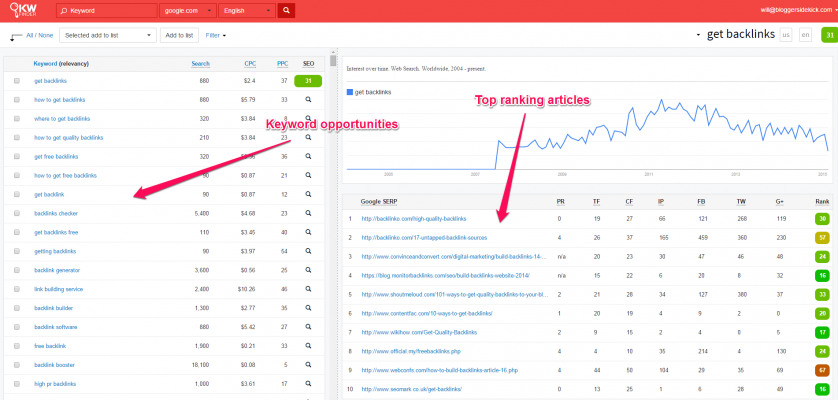
- For each of the top ranking articles for your keyword, copy and paste the link into Moz, BuzzSumo or Ahrefs to analyze what other sites have linked back to it. I used Moz Open Site Explorer to represent this below.
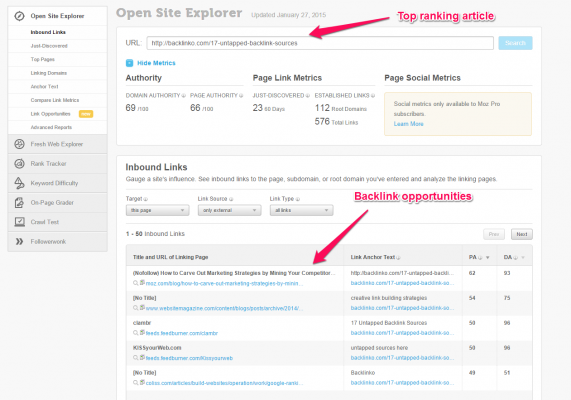
- Chances are your top ranking article is going to have quite a few backlinks if it is featuring on the first page of a search, so it is important to pick the ones that will give you the most return on investment. You can determine this by looking at the ‘PA’ (Page Authority) and ‘DA’ (Domain Authority) for each of the links. Document the ones you choose under ‘Backlink Opportunities’ in your spreadsheet.
- Discover the names and email addresses of the people you will reach out to by going to the linking domains and have a look around. Sometimes this will be obvious, and other times you will need to dig a little deeper. Record the relevant details in your spreadsheet and conduct email outreach to your backlink opportunities.
Tip: Some people might be easier to contact on social media rather than over email. For example, I connected with Ana Hoffman from Traffic Generation Cafe on Google+. See below.
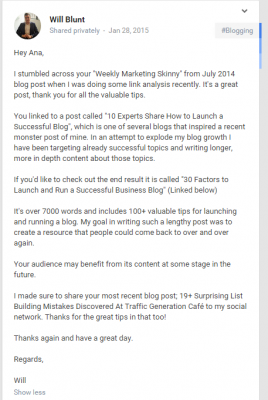
This outreach, followed by some generous sharing, resulted directly in a backlink from Ana’s Weekly Marketing Skinny.
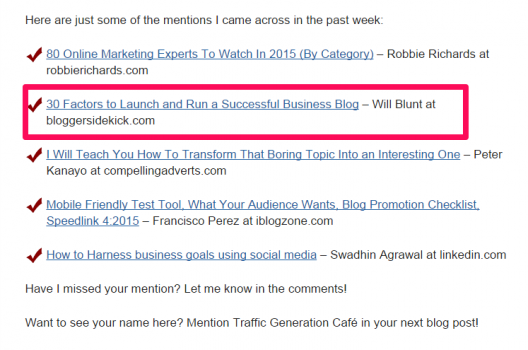
It is up to you how many link opportunities you decide to pursue, but the more you do, the more chance you will have of attracting quality backlinks.
Email outreach can be overwhelming at times, and you need to find a way to track what is working and when you last spoke to someone. Whilst an excel spreadsheet is a great start, you might want to use technology to reduce the time it takes and improve your results. Yesware is some cool software that works with Gmail and tracks all of your email interactions, or if you are looking for an all-in-one relationship manager you might want to give BuzzStream a try.
A quick hat tip to Ian Cleary (Founder of Razor Social) who kindly provided his favorite backlink tactic on Twitter. His advice involves a couple of social media and blogging tools – ahrefs and BuzzStream. That is no surprise seeing Razor Social have collated a directory of the biggest collection of blogging tools anywhere on the internet.
@WillBluntAU Hi Will ahrefs to identify opportunities and then do outreach. Managing using buzzstream
— Ian Cleary (@IanCleary) February 11, 2015
Email outreach is an essential tactic when figuring out how to get quality backlinks for your blog, but you should try and look beyond the link. The relationships you develop from this process are where the real value is. If managed well these relationships will build far more than just links, they will build respect and credibility in your industry.
4. Conduct expert interviews
Remember those relationships you just started forming? More often than not the people you have just connected with are experts in your industry as well. Now is your opportunity to strengthen those relationships and interview those experts on your blog. What does this do?
- Adds enormous value to your readers with the interesting take these experts will have on a topic
- Increases your credibility by placing you alongside these experts in the mind of your readers
- Lets you tap into their network. It makes it far easier to get an email shoutout, Tweet or +1 from these experts when they are the centerpiece of your blog post
- Gets you valuable backlinks. If these experts decide to include a link back to the interview on their own site, which they often will
John Lee Dumas (founder of Entrepreneur on Fire) grew a $2 million dollar business in 2 years, specifically on the back of this concept. Entrepreneur on Fire is a daily podcast that interviews successful entrepreneurs about their story, challenges and lifestyle. John has featured the likes of Jon Morrow, Ramit Sethi and Danny Iny as well as over 800 other entrepreneurs.
I’m not suggesting you can go out and replicate what John has done with your business blog. Of course not. But his success tells us something about interviewing experts. People want to hear from those that have achieved great feats already, so they can fast track their own journey.
Who do your customers aspire to be? Consider interviewing that person.
5. Do expert roundup posts
What is a roundup post?
A roundup post is when a blogger or company collates a long list of opinions from a group of experts about a specific topic. Just like your expert interviews, you are looking to connect with people that have influence over your customers’ behavior.
Why should you create an expert roundup post?
- There is a good chance your experts will have a healthy social following – this means more social shares
- Most people featured in a roundup post (if it’s done well) will leave a comment – this creates a perception of higher engagement
- Your customers trust these people – your credibility skyrockets
- Whoops, almost forgot to mention the most relevant benefit to this post – these type of posts attract more backlinks (Not just from the experts featured, but also from other bloggers who want to link to this type of content)
What is an example?
Robbie Richards published a post in January – 80 Marketing Experts to Watch in 2015. This is an interesting one, Robbie’s blog talks predominantly about list building tactics and he is definitely one to watch. This specific post attracted over 1,000 shares and 30+ comments… Not bad for someone who is just starting out. Chances are without a roundup post, he wouldn’t have got that exposure.
Tip: Don’t just collate, publish and hope. This is a great opportunity to strengthen relationships with these experts. Relationships are the key to your blogging success. If an expert is willing to give up their day to share, comment or contribute to your blog post – you better be grateful. Give more than you ever expect to receive.
6. Leverage guest posting
The benefits of guest posting are exponential. And in the past, submitting an article to an authority site was the easiest way to get a bunch of backlinks. But then Google changed everything. Matt Cutts told the world that guest posting COULD damage your search rankings.
Now everyone is confused. Some say that guest posting is dead. Others think it is better than ever.
I’m in that second lot of people. From my experience, guest posting is just as effective, if not MORE than it used to be.
Why is guest blogging a great growth tactic?
- Boost your profile as a thought leader
- Grow your social media following
- Build valuable relationships (There is that ‘relationship’ word again)
- Take your email list from nothing to something
- Unlock PR opportunities
- Find new customers
- Oh, and get some handy inbound links!
How come Google told us to be careful?
Google’s algorithm wants the best pages (the ones that rank on page one) to have a diverse link portfolio. That sounds like a bunch of jargon, but essentially you don’t want to rely on one single site linking back to you. And you don’t want too many low quality sites linking to your domain.
What this means for guest posting is this;
- Don’t stuff too many links into your guest posts (The best sites won’t allow you to do this anyway)
- Only blog for domains that have a proven track record and a high authority
- Choose a variety of sites to guest blog for, don’t rely on one
Follow these simple principles and guest posting can get you more backlinks. Easy.
Don’t just believe me though. When I asked some of my favorite marketing experts what they did to build links, here’s what they said;
Aaron Agius – Managing Director at Louder Online
@WillBluntAU I’m still a fan of high end guest blogging for brand building, referral traffic and link earning.
— Aaron Agius (@IAmAaronAgius) February 11, 2015
Looks like guest blogging is popular!
Josh Coffy – Twitter guru and Flight Media Founder
@WillBluntAU Guest blogging. 🙂
— Joshua Coffy (@JoshCoffy) February 12, 2015
And again from Barry Feldman…
@WillBluntAU Guest blogging.
— Barry Feldman (@FeldmanCreative) February 11, 2015
7. Broken links
If you have an epic piece of content, one of the best ways to get sites to link to that content is by finding broken links on the same topic. A broken link is one that has stopped working, perhaps a page has moved or no longer exists. They typically show a 404 error page.
The best way to find broken links is to search Google for web pages packed with helpful resources. The idea is to find pages that have a long list of resources on a specific topic, or a collation of helpful links for their community. Industry specific sites, .edu domains and how-to websites are most likely to feature these types of resource pages. (Note: If you get backlinks from edu sites they will skyrocket your search rankings)
I won’t over complicate this process, but here is one way to approach it;
- Search for pages in your industry that collate resources and links
- Use a broken link checker to discover any links that aren’t working on these pages. Some examples are BrokenLinkCheck.com, Dead Link Checker or W3C Link Checker
- Document the links that have stopped working, or throwing a 404 error on these pages
- Contact the website administrator or author of these pages letting them know about the broken links and suggest your resource as a replacement link
You just helped someone else out, started a new relationship and got a backlink to your site. Awesome!
8. Find mentions without links
This is often referred to as link reclamation or reclaiming your links. The idea is to find mentions of your brand in articles, blogs or web copy where the author has chosen NOT to link back to your site.
Here’s one way to find mentions that are un-linked and get the links back;
- Use BuzzSumo Pro to create a content alert for your company or website name
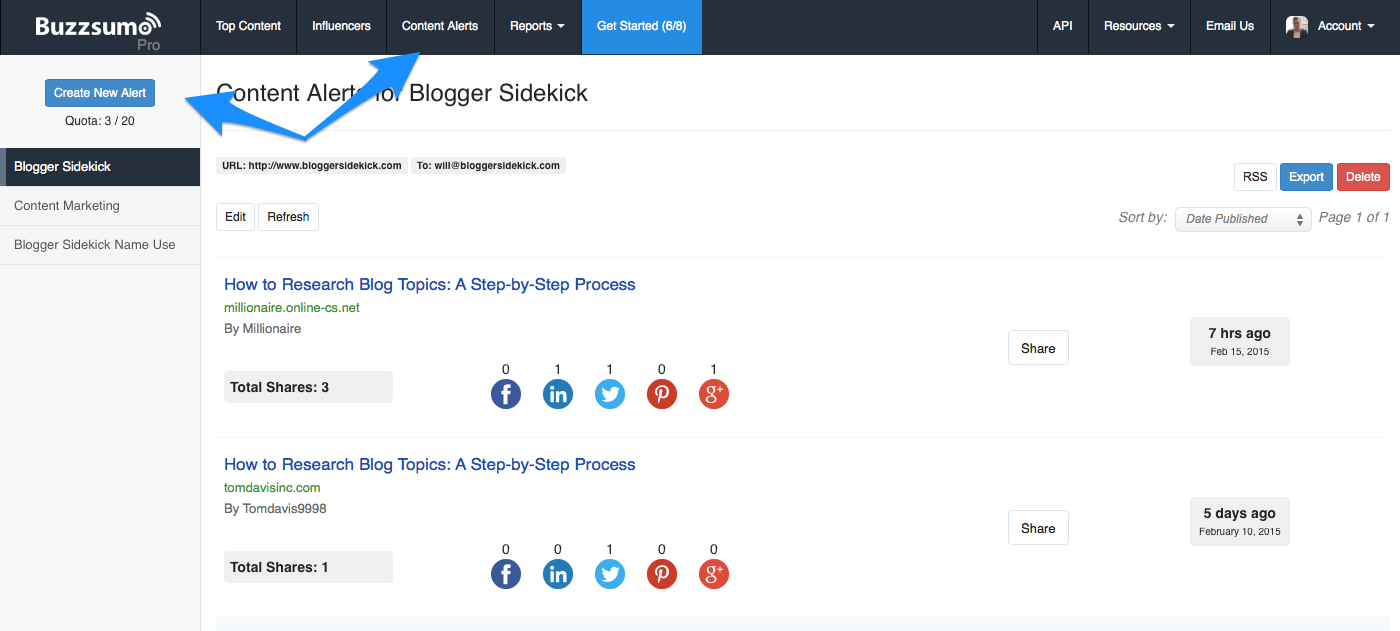
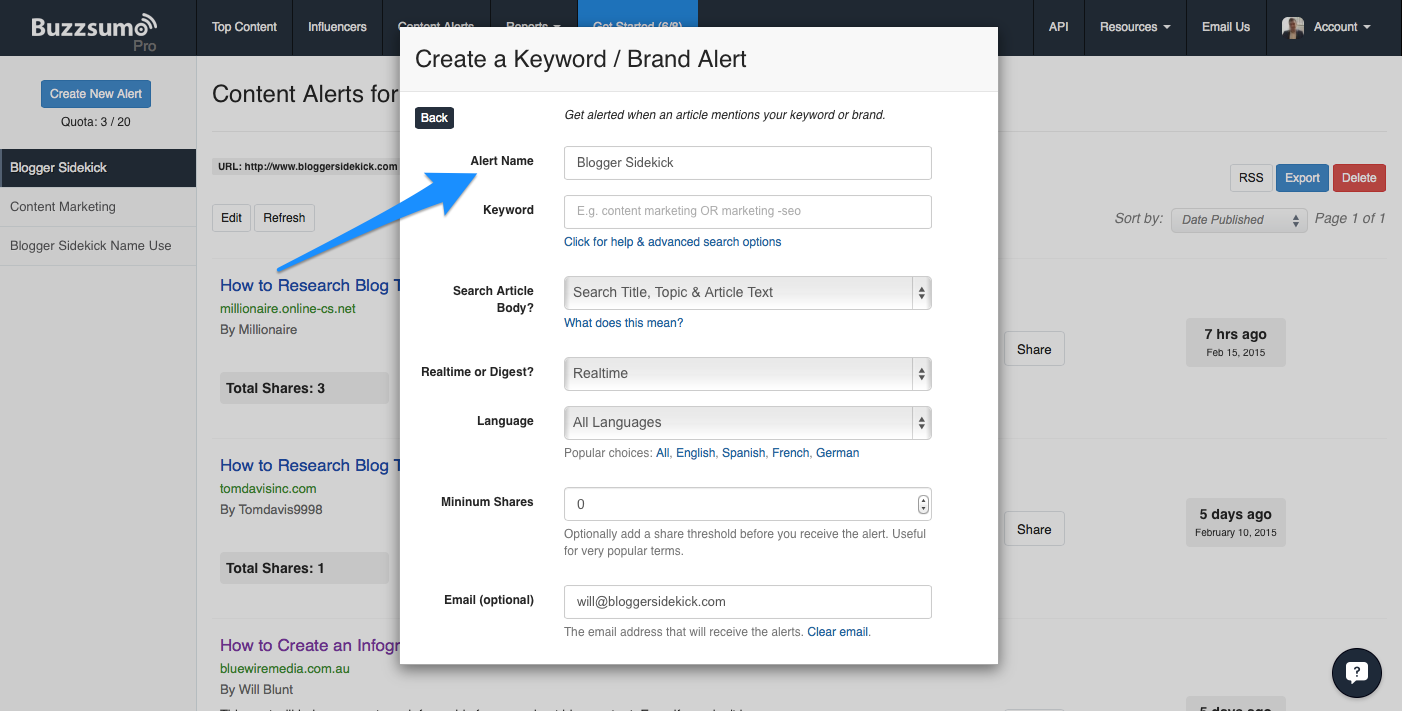
- Record any mentions of your name that do not link back to your site
- Reach out to the authors of those mentions and ask them to link the original text back to your site
This is a really simple tactic that can get you a bunch of backlinks over time if you put in the required relationship building and effort.
If you’re not a BuzzSumo Pro subscriber, just set up a Google Alert.
9. Give testimonials
Giving testimonials is a common strategy used to attract backlinks. After all, what company wouldn’t love getting a testimonial to spruik their product or service offering?
Here’s how to do it;
- Keep an eye out for websites in your industry that have testimonials on their sales pages, and include a link back to the website of the person who gives the testimonial. A great place to start would be with the products, services or tools you are currently using. Below you will see the testimonials on BuzzSumo’s home page, they include links directly back to the sites of those who have given the testimonials.
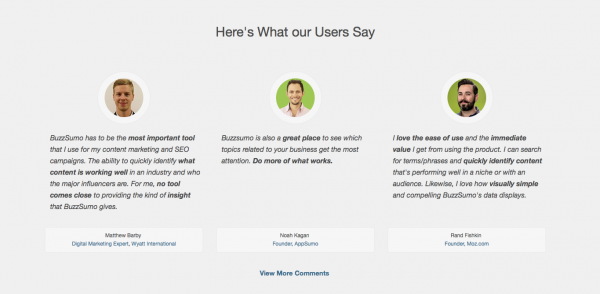
- Have a look at what type of testimonials they tend to use. At this stage you are looking for things like length, selling points and job titles.
- Put together an authentic testimonial that mirrors the testimonials they are already using.
- Reach out via email to someone internally you have interacted with, or a website administrator. Offer a pre-crafted testimonial, a link you would like to include back to your site and a thank you message for the great value they have offered you.
Once you’ve gone through this process with the products you are currently using, you may like to spread your wings. Maybe it’s worth investing in some new products or services to get those valuable backlinks from authoritative sites you are seeking.
Don’t be disillusioned, not every company you reach out to will use your testimonial OR include a backlink to your site. But it is a cool little tactic, that doesn’t take much effort at all.
10. Product or company comparisons and reviews
I haven’t tried this myself yet, but will no doubt give it a go in the near future. And the benefits go far beyond getting quality links.
Here’s how to get backlinks from product comparisons or reviews;
- Create a list of products, tools or services that your readers would regularly use. Or they are considering using. (Hint: These types of posts can be extremely helpful to readers and increase engagement in your comments section)
- Write a blog post ranking them based on a set of criteria OR comparing two of the most common ones OR simply reviewing your favorite.
- If you have written a post that ranks these products and services, reach out to the companies that sell the top couple. Especially if they are ranked number one, they will want to link back to your site. (Bonus: Lots of bloggers use this to review or rank offers when they have an affiliate arrangement with.)
Adam Connell from Blogging Wizard does this like a rockstar. For example one of his posts 12 Best Social Sharing Plugins for WordPress in 2015 has over 200 comments.
Check out how nice Adam makes a product review look in the screenshot below.
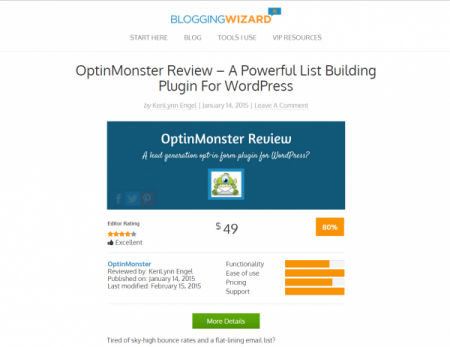
Help your readers, increase engagement, make a new friend AND get a handy backlink. Awesome.
11. Add your blog to directories and blog aggregators
Website directories and blog aggregators can get you backlinks almost immediately from some high-authority domains. There are tons of free blog aggregators and website directories out there, with many of them having questionable credibility. This uncertainty is what scares most people away from submitting their sites, in fear of a Google penalty.
When it comes to website directories it is best to cherry pick a few with domain authority and a good reputation. Brian Dean from Backlinko suggests these free options;
In terms of blog aggregators, take the same mentality. Look for domain authority and a good reputation.
Start with these;
12. Attract PR opportunities to get backlinks
Journalists are craving expert commentary to include in their articles. Online PR services such as HARO and Sourcebottle (if you live in Australia) were created specifically for this purpose; to help journalists find industry experts. More often that not if you contribute a quote or opinion to an online journalist they will include a link back to your website.
Here’s how to be proactive about getting backlinks from PR opportunities;
- Build your personal brand before it’s too late. Or alternatively, help your employees strengthen their own personal agenda.
- Optimize your LinkedIn profile and website bio to include the type of credibility juice that journalists love. (Ie. Achievements, awards, social proof etc.)
- Leverage HARO (or Sourcebottle) to find journalists who need expert commentary by signing up for daily email suggestions.
- Make sure to offer the journalist a link you want them to use in the article (We are link building remember!)
- Capture all of this valuable PR in a media section on your website.
This link building tactic is a bit more of a slow burn, but the great thing about these online PR services is you can let it go on auto-pilot until you spot the right opportunities.
13. Try out the ‘Comment Collection‘ technique
This is more of an engagement technique than a pure link building tactic. But I felt compelled to include it in the post.
First, let me tell you how I came across this technique. I got an email to the ‘Contact’ form here at Blogger Sidekick from a blogger named Luke Jordan, see it below.
Luke was using this technique he had come up with to contact ‘Commenters’ of other popular blog posts, in an attempt to increase engagement on his own blog. Awesome idea right!
So of course I obliged. Commented on his blog and shared it to social media. But I wanted to see if this tactic worked for myself, so I took it to Blogging Wizard and found a post with a whole lot of comments. Adam from Blogging Wizard uses the Disquis commenting system which allows users to see other commenters and their social links or website URLs.
I had written and published a 7000 word post on running a successful business blog, so I decided to use that as the post I would attempt to increase engagement for. Using Luke’s email outreach technique with a sprinkle of my own personality I reached out to a bunch of commenters from Blogging Wizard.
Verdict: It works! Everyone I reached out to responded to my email, some shared it on social and most of them commented on the post.
Why I will keep using this tactic;
- It gave me more comments on that blog post – this creates the perception of engagement (obviously the content needs to be good first)
- I connected with some cool people that are interested in blogging (That relationship thing again!)
- Maybe, just maybe it will get me a backlink or two if I persist. It has for Luke.
Give it a go and let me know whether you get traction. I’m sure Luke would love to hear how it goes for you too, he’s a really approachable guy.
14. Give stuff away for free to bloggers
This is an old school, proven technique for building links.
If you have anything of value to offer; for example a product, service or research report. Find an influential blogger that would find it valuable and give it to them for FREE.
Why would you do that?
- The blogger will most likely write a review about your offering – that’s an immediate backlink
- The blogger will love you forever and bloggers are pretty good friends to make. There is every chance they will link back to your service over and over again in good faith
- Bloggers have a highly engaged, extremely targeted audience that trust every word they write. Pick the right ones, and a single recommendation from them can deliver you lots of direct sales (Hint: Offer an affiliate link or discounted price to any leads that come directly from your blogging advocate)
For this tactic; jot down a bunch of influential bloggers that could benefit from your offering, conduct an email outreach to each of them and watch the backlinks come flowing in!
Tip: Don’t overtly ask the blogger for a link or a review. They will make that decision themselves if they value what you have to offer them.
15. Reddit
Reddit is a beast that most marketers shy away from. It has an overwhelming amount of content, and figuring out how to cut through the clutter is a real challenge. But if you approach Reddit in the right manner, the benefits can be pretty surprising.
The two main benefits of building a presence on Reddit are direct traffic and do-follow backlinks. That’s right, I said do-follow backlinks.
A common misconception with Reddit is that the service only offers no-follow links when you post. Which for the average user is correct. If you go over to Reddit, start an account and begin posting links back to your site they will not directly benefit your link building efforts. However, if you submit a post to Reddit that gets enough up votes, your link will convert to a do-follow link. Light bulb moment right?
But how do you create engagement on Reddit?
- Find relevant Subreddits. Subreddits are like mini communities within Reddit that discuss specific topics. Do some research into what the most engaged Subreddits are in your industry and pinpoint a few that you will look to engage.
- Add value to your Subreddit community. You won’t get up votes if you just post links with no context or obvious value for the members of the community. Just like any social network you must first build credibility and trust with helpful content.
- Join the conversation. Be a participant in other conversations, not just your own posts. This will let the community know that you are a genuine contributor, not just a marketer looking to steal a few backlinks.
- Make your content interesting. As with any type of content marketing, the key is understanding what works and what doesn’t with Reddit. Test out a variety of headlines, use imagery, vary your text, ask a question. Soon you will find a rhythm that works.
Here is a resource you may find interesting if you want to read more about Reddit marketing. Thanks to Brandon Shrair from Viral Blog Content.
Bonus: No-follow links from Quora, Scoop.it and Industry Forums
I grouped these three tactics together because they don’t typically get you direct do-follow links (Some forums provide do-follow links in your profile signature, but this is becoming rarer and rarer).
So if you are on a mission purely to get do-follow links then Quora, Scoop.it and industry forums are not the quickest way to do so. But they are certainly untapped sources of web traffic and targeted communities that most marketers are ignoring. The more people that see your content, the more people that will eventually link back to it. And both of these networks have a way to get your content in front of a large, highly targeted audience.
Here’s how;
Quora
- Start an account with Quora and optimize your profile to drive traffic back to your website.
- Setup a ‘blog’. Below you will see the menu where you can set up and access your Quora blog. The process is fairly simple.
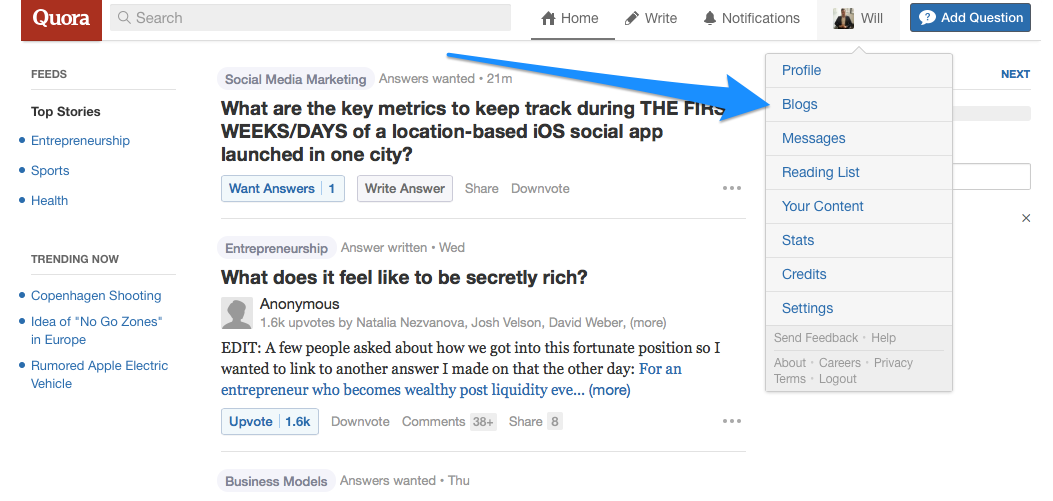
- Every time you publish a blog post on your website, create a brief summary of the content and re-post this summary as a blog post on Quora with a link back to the original.
- Join the conversation. As with any social network or online community, this is the most important step. With Quora it is easier than most networks, because people are directly asking questions. Search for questions that the Quora community is asking in your industry, answer those questions, drive traffic to your Quora profile and then drive traffic back to your website.
John Paul Aguair wrote about how he attracts traffic from Quora in a recent blog post if you’re looking for some further reading on this.
Scoop.it
- Create a Scoop.it account. You can sign in using your Twitter or Facebook profile in under 2 minutes! (Note: At this stage you may like to set up your own Scoop.it page for people to follow)
- Use the Scoop.it search function to discover content pages that are relevant to your industry. Below I have done a search for ‘content marketing’ to show you what I mean.
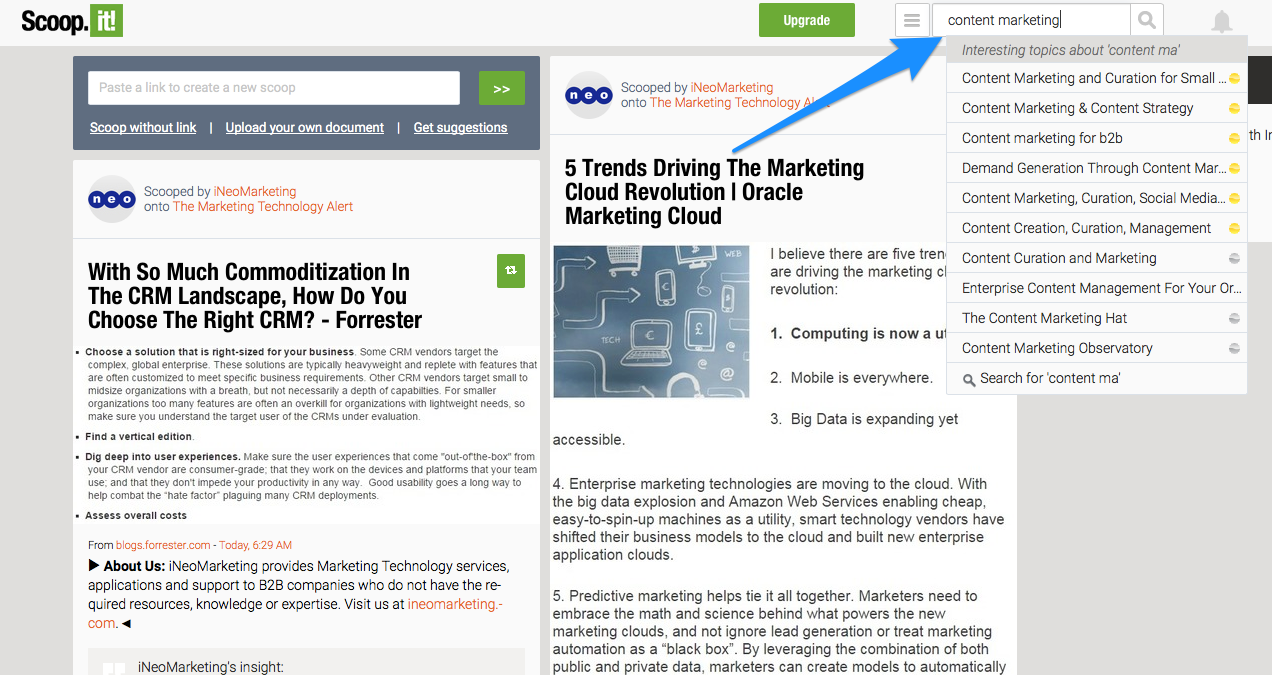
- Once you have found a few high traffic pages, it’s time to make the most of the Scoop.it suggest function. Below is a page called ‘Social Media, SEO, Mobile, Digital Marketing’ created by Kamal Bennani, which has had over 50,000 views and accepts link suggestions at the top left of the screen.
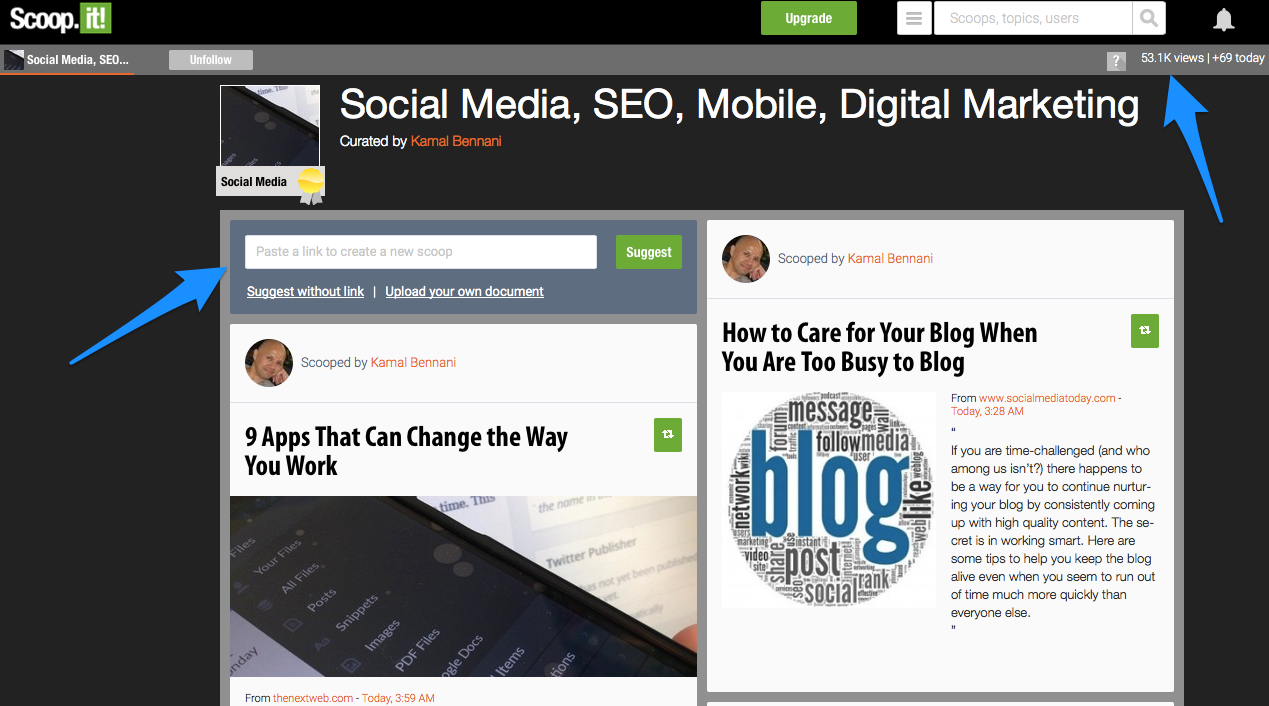
If you want to increase your chances of a popular Scoop.it page accepting your link suggestion, add a personalised message with it. Most Scoop.it page owners will either accept or decline your content suggestion within 24 hours and you can expect a strike rate of about 50-60%. That’s if your content is good!
Promoting your content on Scoop.it is super easy, and any links it attracts for your site are ones that you wouldn’t have had otherwise.
Industry forums
- Find a group of relevant forums in your industry that discuss the type of challenges you can help solve. The quickest way to do this is to try a basic Google web search for a few different keyword terms; keyword term + forums
- Once you have found some relevant forums with high engagement, and a decent domain authority, set up your user profile. Typically the user profiles on forums will give you an opportunity to include a no-follow link back to your website
- Join the conversation. Use the forum search functions to find questions you may be able to answer, or even better questions that you have already created content to answer.
- Don’t spam. The worse possible thing you could do when starting out in a forum is to drop links into your first few posts. Build a reputation as a contributor first, and develop relationships. Once you have established some credibility as a valuable user, then you can start to share links within the answers you provide.
A highly targeted audience, loads of engagement and the potential of some juicy backlinks… Three very under-utilised and seriously effective tactics for getting your content found and linked to.
Conclusion
Despite regular search algorithm updates and conflicting advice, one thing is certain; if an authoritative domain links to a page on your website it is a good thing. But it is important to familiarise yourself with what a “good” link actually is, and how you go about getting those links.
I hope that you can come back to this post as a reference point. Try out these tactics one at a time, see what works, what doesn’t and adapt your strategy along the way. But don’t obsess over “link building”. In the end it is relationships that matter. If getting backlinks leads you down a path to build some wicked relationships with some influential people, then it is worthwhile.
What other tactics have you found effective to attract inbound links to your blog?

